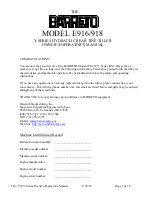
74
CTV-PRB004-EN
Glossary
Amps, primary rated-load amps (RLA)
Commonly referred to as the selection RLA or the unit
RLA. This is the amperage that is drawn when the chiller
is at full cooling capacity in terms of cooling tons (kW).
RLA is listed on the nameplate, and it is the key number
used to size the starter, disconnects, circuit breakers, and
Adaptive Frequency Drives (AFD) for a typical chiller. It is
also the value used to determine the minimum circuit
ampacity (MCA) for sizing conductors. Primary RLA is
always less than or equal to the motor full-load amps
(FLA).
Anti-recycle protection
A control method that limits the number of compressor
starts within a given time period. Prior to 2000, the
CenTraVac was limited to one start every 30 minutes
(30 minutes from start-to-start).
Today, a more flexible protection system called restart
inhibit is utilized. Typically several rapid restarts are
allowed before a time limit is set. The time limit, if
enforced due to several rapid restarts, is dependent on
motor winding temperature, unit size, and an adjustable
delay time constant.
This protection is a standard feature of the CenTraVac
control panel.
Available fault current (AFC)
Electrical engineers usually calculate and design to a
potential short-circuit current that originally comes from
the utility power system. They call this term the available
fault current because they take the potential fault current
and then evaluate it via computer programs to determine
an available fault current just upstream of the chiller
starter or frequency drive. The starter short-circuit current
rating should be greater than or equal to the available fault
current to safely contain starter components should a
short-circuit occur.
B
Bus
A bar of conductive material—usually copper—used to
carry large electrical currents to supply multiple circuits or
components. A bus is typically used to connect several
medium-voltage starters together and thereby require
only a single power connection for incoming line power.
C
California code
Available on CenTraVac chillers with low-voltage starters
(UL as standard) with disconnects or circuit breakers. Low-
voltage starters with terminal blocks require a special
configuration which is available as a standard option in the
order system. On medium voltage, the standard UL
certification satisfies California Code requirements.
Circuit breaker
A device that protects a circuit by opening its contacts
when a current responsive element senses overcurrent or
short-circuit current. A circuit breaker protects electrical
components from further damage if any one component
within that system experiences a short circuit. Circuit
breakers are used on low-voltage starters only. The
overload function is not used; overload is accomplished by
the chiller controller. Circuit breakers are sized based on
the primary RLA from the nameplate, the required AIC of
the breaker, and the required SCCR of the starter
enclosure.
Contactor
A multi-pole relay whose contacts are rated to carry line
current. The contactor connects and disconnects a motor
to and from line power. The coil of a contactor may be
operated by line voltage, control voltage, or through a
rectifier (DC voltage).
Control-power transformer (CPT)
A device that reduces incoming line voltage to control
voltage (i.e., 480 V to 120 V). The control-power
transformer is usually located in the starter. A 4 kVA
transformer is provided as standard in CenTraVac
starters—3 kVA transformer provided with AFDs. The
Enhanced Electrical Protection Package provides an option
to mount the CPT separately on the side of the chiller. This
transformer takes care of the chiller’s auxiliary power
needs such as the purge, oil pump, heater, etc.
Corona
A visible pale glow surrounding an insulated conductor
typically carrying over 2000 volts. Ozone odor is present
and the air around the wire becomes ionized. An increase
in voltage may cause the corona effect of adjacent wires
to increase until spark-over occurs. See “Stress cone
(stress relief cone),”
p. 80
.
Current-limiting fuse
A current-limiting fuse is a fuse that recognizes the rate of
current increase and will melt its element and open the
circuit in less than one-quarter of an electrical cycle in the
event of a short circuit. Thus, the total short-circuit current
available never passes through the current-limiting fuse.
CenTraVac medium-voltage starters contain three current-
limiting fuses as standard.
CTV-PRB004.book Page 74 Sunday, December 18, 2011 6:39 PM









































